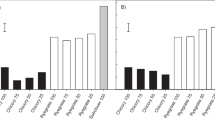Summary
A study has been made of specific effects and interactions of Ca, Cu, Mo, and P on the symbiotic system and chemical composition of subterranean clover, (Mt. Barker var.) grown in sand culture under glass on high and low nitrate supply. The levels of Ca and Cu were low while those of Mo and P were in general high or excessive.
N2-fixation appeared to be specifically inhibited by deficiencies of Ca or Cu but was only affected by Mo or P according to their effect on yield. The classic symptoms of Ca- and Cu-deficiencies were obtained on highnitrate plants, but in symbiotic plants they appeared as symptoms of Ndeficiency. This was confirmed by chemical analysis.
The main yield interactions were Ca×Cu, Ca×P and Cu×P which were explained by the chemical data. Toxic effects of excess P which were observed were relieved by the increased growth rate associated with higher levels of nitrate or Ca, but were intensified by increased levels of copper. Higher levels of nutrient-P enhanced equally the Cu- and Mo-content of tops.
Copper deficiency depressed the uptake of Ca into the tops.
Similar content being viewed by others
Bibliography
Barshad, I., Molybdenum content of pasture plants in relation to toxicity to cattle. Soil Sci.66, 187 (1948).
Barshad, I., Factors affecting the molybdenum content of pasture plants: I. Nature of soil Mo, growth of plants and soil pH. Soil Sci.71, 297 (1951).
Barshad, I., Factors affecting the molybdenum content of pasture plants: II. Effect of soluble phosphate, available nitrogen and soluble sulphate. Soil Sci.71, 387 (1951).
Brown, J. C. and Holmes, R. S., Iron, the limiting element in a chlorosis: Part I. Availability and utilization of iron dependent upon nutrition and plant species. Plant Physiol.30, 451 (1955).
Brown, J. C., Holmes, R. S. and Specht, A. W., Iron, the limiting element in a chlorosis: Part II. Copper-phosphorus induced chlorosis dependent upon plant species and varieties. Plant Physiol.30, 457 (1955).
Brown, J. C., Holmes, R. S., Shapiro, R. E. and Specht, A. W., Effects of phosphorus and copper on iron chlorosis of rice in flooded and non-flooded soil and the associated enzymatic activity. Soil Sci.79, 363 (1955).
Greenwood, E. A. N. and Hallsworth, E. G., An evaluation of the maximum radius of the rosette as a growth index for subterranean clover. Plant and Soil12, 49–56 (1960).
Hallsworth, E. G., Nutritional factors affecting nodulation. Proc. Univ. Nottingham 5th. Easter School in Agr. Sci. (Ed. E. G. Hallsworth). Butterworths Scientific Publications, London, p. 183 (1958).
Hewitt, E. J., Sand and water culture methods used in the study of plant nutrition. Commonwealth Bur. Hort. Plantation Crops Tech. Common.No. 22 (1952).
Millikan, C. R., Nutritional disorders in subterranean clover. Dept. Agr. Victoria Tech. Bull.No. 11 (1953).
Norris, D. O.,Rhizobium needs magnesium not calcium. Nature182, 734 (1958).
Piper, C. S. and Beckwith, R. S., Uptake of copper and molybdenum by plants. Proc. Spec. Conf. Plant Animal Nutrition Australia 1949, 144 (1951).
Purvis, E. R. and Peterson, N. K., Methods of soil and plant analysis for molybdenum. Soil Sci.81, 223 (1956).
Rediske, J. H. and Biddulph, O., Adsorption and translation of iron. Plant Physiol.28, 576 (1953).
Rossiter, R. C., Phosphorus toxicity in subterranean clover and oats grown on Muchea sand, and the modifying effects of lime and nitrate nitrogen. Australian J. Agr. Research3, 227 (1952).
Rossiter, R. C., The influence of soil type on phosphorus toxicity in subterranean clover. Australian J. Agr. Research6, 1 (1955).
Shive, J. W., Toxicity of monobasic phosphates towards soybeans grown in soil and solution culture. Soil Sci.5, 87 (1918).
Stout, P. R. and Meagher, W. R., Studies of molybdenum nutrition of plants with radio molybdenum. Science108, 471 (1948).
Stout, P. R., Meagher, W. R., Pearson, G. A., and Johnson, C. M., Molybdenum nutrition of crop plants I. The influence of phosphate and sulphate on the absorption of molybdenum from soils and solution cultures. Plant and Soil3, 51–87 (1951).
Teakle, L. J. H. and Turton, A. R., The copper, manganese and zinc content of subterranean clover and oats in Western Australia. J. Dept. Agr. Western Australia20, 238 (1943).
Williams, R. F., The effect of phosphorus supply on the rate of intake of phosphorus and nitrogen upon certain aspects of phosphorus metabolism in gramineous plants. Australian J. Sci. Research Ser. B1, 333 (1948).
Woodman, R. M., Nutrition of vegetables in sand. Ann. Appl. Biol.31, 22 (1944).
Woodman, R. M. and Johnson, D. A., Plant growth with nutrient solutions. IV. J. Agr. Sci.37, 163 (1947).
Loneragan, J. F., Calcium in the nitrogen metabolism of subterranean clover. Australian J. Biol. Sci.12, 26–39 (1959).
Author information
Authors and Affiliations
Rights and permissions
About this article
Cite this article
Greenwood, E.A.N., Hallsworth, E.G. Studies on the nutrition of forage legumes. Plant Soil 12, 97–127 (1960). https://doi.org/10.1007/BF01377365
Received:
Issue Date:
DOI: https://doi.org/10.1007/BF01377365




